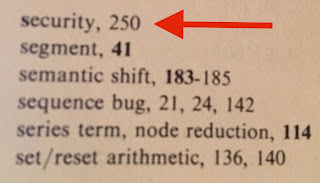In support of this organization, Matusow published The Beast of Business in 1968. The book begins by explaining that "abolition" doesn't exactly mean abolition:
The purpose of the International Society for the Abolition of Data Processing Machines is not to do away with positive uses of the machine, or of the computer in society. After all, the computer does have a good, healthy and constructive function in mathematics and the other sciences, and in solving certain problems facing, for instance, scientists, architects, and engineers.
But when the uses of the computer involve business or government, and the individual is tyrannized, then we make our stand. ... The ISFADPM is not opposed to [computer] use in the laboratory, assembling mathematical formulae, working for the physicist, the chemist, the engineer. But when the government starts to use the computer for ends (which are planned) such as filing banks of information, complete dossiers on every individual in a country, you end up with the kind of Big Brother State predicted by George Orwell in 1984.
Matusow describes a bright line between using computers in hard sciences versus soft sciences. He was not necessarily alone here -- privacy concerns over computers in the social sciences had been raised years earlier. Then the tone quickly changes, with a manifesto warning against the loss of personal freedoms via obedience to technology. (This manifesto is vaguely reminiscent of another more famous one.)
ManifestoOf the International Society for the Abolition of Data Processing MachinesYou are a member of society. That society is made up of free citizens and free people. These free people through free elections have determined that their free institutions will continue to exist. They have declared that, if necessary, they would defend their right to live with their freedom, in their free way, and continue to enjoy the benefits and privileges which are guaranteed to citizens in free countries.It is upon you and your friends, faced with an over-technological society, that the future of your country rests. Your country and your society have been placed in jeopardy: their defence is possible only if you face up to the challenge presented to you by the abuse of the computer.In the transition from non-computerised life to life in a Big-Brother, computerised society you may at first feel confused. It is the purpose of this book to help you over these rough spots as rapidly as possible and to lay the foundations for your successful career as a Computer Fighter.Making a good Computer Fighter is no different from making a good citizen. The rules are the same - Know Your Own Job, Know your enemy and be ready to step into the job of the man ahead of you.
Most of the book is presented as a series of anecdotes, none of them sourced, many of which sound like urban legends. An example: "A major computer installation in Denmark ran into trouble in the summer of 1968. It seemed to go haywire and was giving out all sorts of mis-information. Upon investigation, specialists found the computer's ailment was SUNSTROKE." (I was unable to find any further information about this incident.)
One of the final sections of the book is a "guerrilla warfare manual for striking back at the computer", which includes the following helpful tip: "Women going into a room with a bank of computers are advised to wear a lot of the cheapest perfume they can find - filling the room with an odour which can affect many allergic computers."
Given Matusow's general eccentricity, I'm guessing he wrote most of this with a straight face. It's a weird and interesting time capsule of the early confusion and fear caused by computers.





